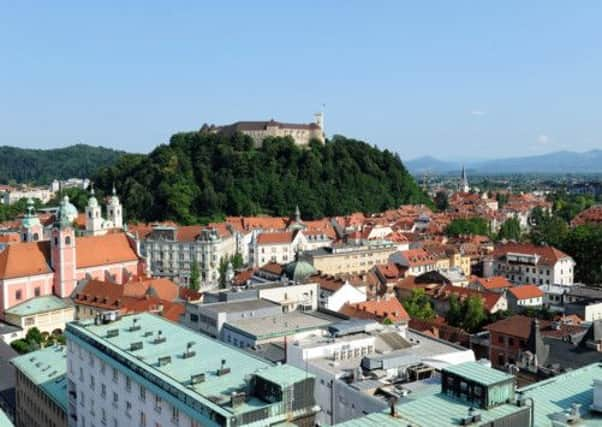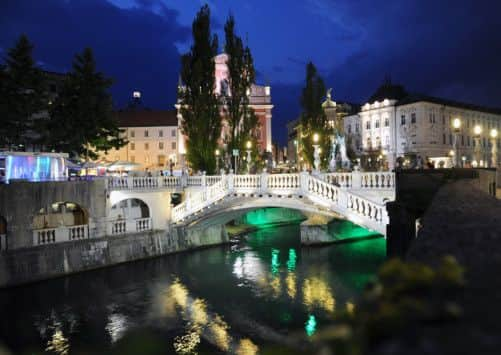Peace in our time


Ljubljana. Not the world’s most obvious tourist destination. Slovenia in general howls in the wind, too often confused with a nearby neighbour. A few years ago it began producing T-shirts bearing the slogan: “We love Slovakia – but we’re Slovenian.”
However, while it might not be at the top of most people’s lists of place to visit, pushed out by the likes of Paris, Barcelona and Rome, if you do make it there, you’ll wonder why this picturesque land with its delightful capital is so untouched and so far below the radar. In a frantic 24-hour age, Slovenia is one of Europe’s few remaining sanctuaries. The appeal and tranquility stares back at you, in Ljubljana and beyond.
Advertisement
Hide AdAdvertisement
Hide AdA colleague and I found ourselves there for nine nights during a recent football tour involving Leeds United. We were as uninformed as the next man – prone to booking flights to Bratislava by mistake – but quickly seduced by a country which sets an example to others in the Eurozone. There is no arrogance or stench of nationalism there; just pride in their many assets.


Take Ljubljana. They don’t sweep the streets of the capital, they wash them religiously. The streets in turn are lined with beauty. You’ll see symbols of socialism in the architecture – Slovenia was part of Yugoslavia until 1991, though never behind the Iron Curtain – but far more of the baroque era: beautiful ceramic tiles covering the buildings which snake along Ljubljana’s river. Its cathedral, with doors commemorating the visit of Pope John Paul II in 1996, is magical and paintings inside resemble the Sistine Chapel.
The city was Roman for a time until Attila the Hun had one of his moments and burned them out. Preserved walls are on display in underground exhibits beneath the Star Park. All of this sits in the shadow of Ljubljana castle, high on a mount in the very centre of town. Again, the investment in the castle is evident at first glance. This in a place where the average wage is £850 a month.
We stayed at the City Hotel in the heart of the capital, a clean, comfortable and fairly basic residence. It served a wide-ranging breakfast – Slovenian in parts, continental in others – and offered excellent wifi. The whole of Slovenia offers excellent wifi, most of it freely available in shops, supermarkets and pubs. The food has a rustic taste, centring on the staples of bread, meat and vegetables, but foreign fare is everywhere. Meals in the hotel proved to us that potato croquettes did not, in fact, go the way of Communism.
Advertisement
Hide AdAdvertisement
Hide AdUnderground parking at our lodging struck us as rather steep at 18 euros a night but the hotel’s staff were honest and upfront about the charge. Honesty is Slovenia’s byword. On-street parking meters charge just over a pound for two hours and will not swallow a penny more. On the many occasions when we forgot to ticket our hire car, the traffic wardens spared us a penalty. But then traffic congestion in Ljubljana is no problem at all.
Sixteen miles from the main airport, you arrive in quick time and find a warm atmosphere at all hours. Parts of the continent have a knack of creating a nightlife which embraces families and children. Ljubljana is rated as the fifth safest city on the planet and it feels like it. It must also be one of the cleanest. There is zero prostitution or anything of the sort. To put that another way, you will find no stag-dos there.
For kids there is a puppet theatre and many legends relating to the dragon which once stalked Ljubljana. For adults, take your pick: scores of riverside bars and cafes and live music in just about every street.
On our last full day we were taken by the Slovenian Tourist Board to Strelec, a restaurant on the walls of the castle. It was Michelin Star without the star and, in the interests of transparency, we should confirm that they paid. But at £30 for five courses – pate, seabass, cheese rolls (goat’s cheese souffles to you and me), trout/beef cheeks and apple strudel – it was hardly extortionate for sensational food and a wonderful view.
Advertisement
Hide AdAdvertisement
Hide AdThe following day we visited Lolita, a patisserie owned by the same company a little way down the the hill. Think Charlie and the Chocolate Factory’s older, more sophisticated sister. You pay for the confectionary but in relative terms – a piece of cake went for around £3. Lager in Ljubljana sells at £2 a half-litre and food was markedly cheaper than in the UK. The euro is doing what it always does but you won’t feel short of cash unless you start short of cash.
Our journeys on Slovenia’s pristine motorways took us to its eastern reaches, to Domzale, Ptuj, Kidricevo and Murska Sobota. The towns were nothing to write home about (we went there to work) but the scenery was grand. We ran out of time before we could visit Postojna Cave Park – an enormous run of tunnels and halls – but it recently saw its 35th million visitor which tells you everything (the lucky punter won a cake). Slovenia’s coastline is worth a look too, situated on the Adriatic Sea and a short hop by car from Ljubljana. The average temperature in the summer sits hovers around 30 degrees centigrade. Slovenia has been starved of publicity for years. But when you breach the border and take it all in, you realise that you could lose yourself there. We did.